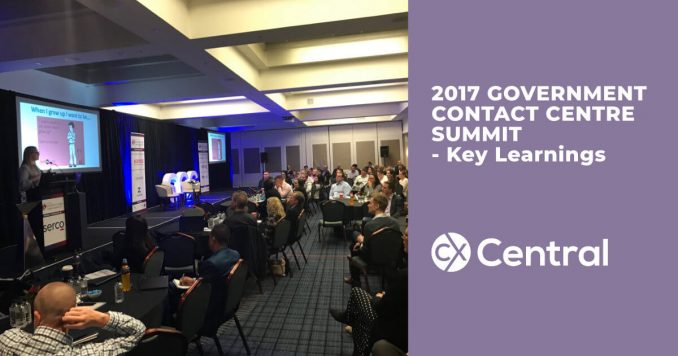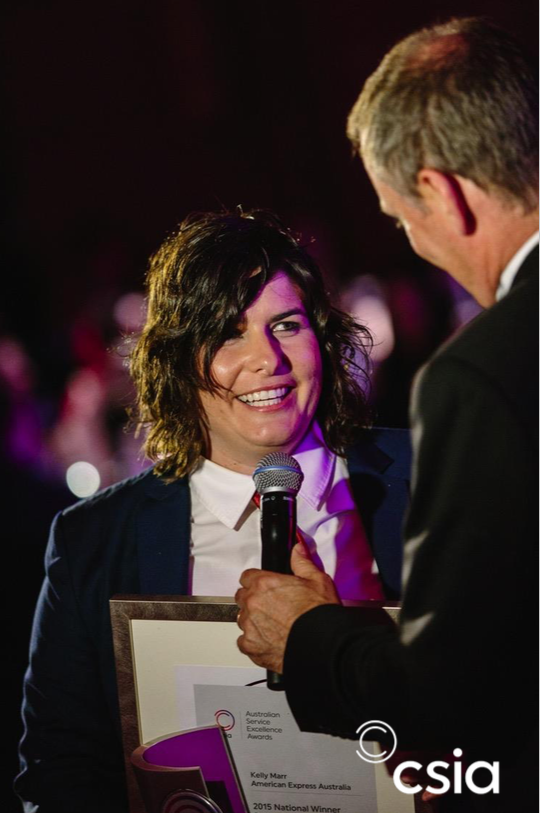
2017 Government Contact Centre Summit Highlights
A couple of weeks ago I had the great pleasure of chairing the 17th 2017 Government Contact Centre Summit in Sydney that brought together government contact centres from across Australia to learn, share and network on all things contacts centres and customer experience.
We had some fantastic speakers, breakout sessions and even some speed networking over two days providing ample opportunities for everyone to pick up some great tips, ideas and inspiration to take back to their workplace.
Whilst the conference was geared towards the public sector, many of the challenges they face are no different from the private sector!
Yes, there are some nuances around restrictions on Reward & Recognition programs for some centres but many of the challenges are the same regardless of which side of the fence you are on – recruitment, retention, budgets etc.
If you weren’t able to make it to the 2017 Government Contact Centre Summit (or even if you did!) this should provide a good overview of some of the key takeaways and learnings.
2017 Government Contact Centre Summit – key takeaways
The key takeaways for ‘busy’ people
I know, your busy right and don’t have time to read the whole article… So just for you here’s some quick dot points:
- The barrier to technology has never been lower.
- Technology is continuing to erode the more basic calls meaning the complexity of the calls is increasing.
- Getting the basics right is critical. Recruitment, induction programs, coaching and how we reward and engage our staff are fundamental to delivering a good customer experience.
- Culture eats strategy for breakfast. CX has to be lived and breathed by the leaders in the business.
- People are divided over whether Millennials are/should be treated any different.
- You need to benchmark your CX delivery to everyday interactions your customers are having with all businesses, not just the ones in your little bubble.
- Customer expectations (and staff’s) are changing along with their preferences.
- The single view of the customer is a challenge for most of us.
- Personalisation is something you’re going to hear a lot more about.
OK so now you’ve got the general gist but I seriously spent a lot of time putting this together and there are some more gold nuggets of information below so I hope you find the time to read the rest
The Futurist
It wouldn’t be a contact centre conference if we didn’t include a presentation from a Futurist and Nick Abrahams did not disappoint!
Nick provided a great insight into some of the technology that is already impacting our lives now, and into the near future because even if you’re not ready for it, as Mike Tyson adequately summarised “Technology is going to punch you in the face!”

Nick provided numerous examples of the changing requirements of customers, especially those millennials.
As he mentioned, Neil Armstrong took 5 photos on his trip between the earth and the moon and his niece takes 5 photos just walking to the next room and back!
So yes communication preferences are changing and with it, the requirements on how organisations will need to communicate with their customers.
Nick also provided insight into new technology that’s happening now, from augmented reality, Soul Machines and complex issues like the Chinese Social Credit Score which got everyone’s mind into hyperdrive!
The Lightbulb Moment
In every conference, there are always a few comments that hit home.
Rod Moynihan from Zendesk gave one of the best takeaways from the conference (in my humble opinion) warning of the danger of companies just benchmarking their CX against their direct competitors.
Why? Because customer expectations are increasing regardless of what sector you are in or any particular business vertical.
For example, if you are the local council, don’t go and compare your CX to another local council because your customers aren’t!
They are comparing their experiences across every business they interact with – from their bank, insurance company, ordering an Uber etc – those everyday interactions are now what you are being compared to.
I mean why is it so hard to pay an annual car registration when I can order a nice meal and have it delivered to my house in minutes thanks to Uber Eats?
So the message was clear, widen the net in how you measure your CX because you are now being judged and compared all day, every day.
Professional Recognition & Standards
Anouche Newman, CEO of Customer Service Institute of Australia (CSIA) provided an overview of the International Customer Service Standards ICSS:2015-2020 and the Australian Service Excellence Awards that are facilitated by CSIA.
The passion Anouche has for lifting the profile and recognition of those working in our industry to be seen as ‘professionals’ was certainly infectious and its clear what the recognition means to individual winners and organisations:

“Perhaps the closest I will ever get to winning an Oscar. The only difference is this isn’t a performance, it’s recognition for striving to put the customer at the heart of what my team do and genuinely believing in the power that can deliver to our business.” KELLY MARR – Team Leader, AMEX Global Servicing Network 2015 Customer Service Leader of the Year
American Express Case Study
Andrew Carlton, former manager of the American Express Contact Centre and now the owner of Virtual CX Consulting provided an overview of some of the innovative approaches he undertook to improve a range of metrics that resulted in a number of CSIA awards.
These included:
- Having new staff start as ‘Customer Service Apprentices’.
- Not referring to phone conversations as transactions but rather interactions.
- Throwing away scripts.
- Mandating that 60% of a Team Leaders time is spent coaching with 2 hours of coaching per agent per month. 4 x 30 minutes per week single focus sessions worked best.
- Not using the Average Handling Time metric. You might like to read a previous article on Why the Average Handling Time (AHT) Metric should be extinct that will support that view.
Genesys/GSN and the Back Office
While we’ve all spent the past 30 odd years getting our head around the Front Office (i.e. customer facing), there has always been a certain intrigue around the Back Office.
As Phil Anderson explained, it’s a bit like a black hole where work gets allocated to but never escapes.
We’d like to tell you more about what happens in the black hole, but no one has ever gone in there and escaped…
The combined presentation from Phil, Len Power and Jim Campbell demonstrated how all the traditional call centre technology and process logic is now working its way into the back office providing full visibility of customer transactions and unlocking efficiencies that to date have not been available.
Digital Disruption and the best one-liners!
If there was a crowd favourite from the conference I’d be putting my money on Ole Nielsen.
Aside from having a pretty incredible story about being saved by a whale while scuba diving one day, Ole is the Deputy Chief Officer and Director of Digital Transformation, Chief Minister, Treasury & Economic Development Directorate ACT.
Hell, that title needs a paragraph all by itself!
Ole’s presentation effectively summed up much that is wrong with the business models we run today and provided a humorous (and somewhat painful) reminder of some of the traditional barriers businesses either intentionally or otherwise place on individuals who are trying to instigate change.
Ole rolled out plenty of memorable one-liners including:
- The definition of a meeting – where minutes are kept and hours are lost.
- Where is your business case? is short for “I don’t care!”
- You’ve heard of SaaS, well business seems to be very good at implementing Naas – No as a Service.
Aside from some great one-liners, Ole provided some tips and quotes on how businesses need to become more agile in today’s world:
“Healthier organisations are possible when you stop comparing them with machines and, instead, compare them with communities.” The world is too complex to give you merely a list of practices to follow. – Jurgen Appelo – Thought Leader, Management 3.0
Ole’s tips on how to be more agile:

Finally Ole provided some great motivational tips on not being afraid to take things on and drive change. Top tips included:
- Get Started – Do Not Wait
- Empower yourself and others (yes you can!)
- Focus on [user | value | customer ]
- Dream Big, Small Steps, Learn, Adapt
- Collaborate
- Be Open
The panel discussions
There were a couple of great panel discussions during day one with the first one featuring Andrew Agnew, Amanda Rice and Trevor Bale focussing on a range of topics including Leaderships skills, Change Management and KPI metrics.
The panel members all represented different sizes centres (which was a great idea!) and as I was facilitating the discussion I don’t have a heap of notes to go off (and I’m getting old so have the memory of a sieve!) but my key takeaways from the discussions were:
- There is no one size fits all approach in contact centres. They are all different, have different personalities and require different approaches.
- There is still plenty of debate on the best metrics to measure performance with AHT still widely used as an agent metric.
- Despite all the advances in technology, getting the basics right with recruitment, coaching and having the right KPI’s is something most centres are not fully on top of.
- Contact centres are in a permanent state of change.
- Nearly everyone knows the importance of measuring quality but how to actually do it is another thing altogether…
The streams…
Like any good conference, the 2017 Government Contact Centre Summit attendees had the option to choose how they spend their afternoon with two different paths – Stream A Digital Innovation or Stream B Setting up a Contact Centre and Consolidation of Contact Centres.
Apologies to our Stream B presenters as I was chairing Stream A so missed out on your great presentations. Here’s a quick recap of Stream A:
Do Social Media complaints carry more weight than any other channel?
The second panel discussion of the day was a debate on whether Social Media Complaints carry more weight than any other channel. Arguing for the ‘For’ was Hugh Greenough and ‘Against’ was Peter Buckmaster.
I was expecting some genuine fireworks and some hard-hitting blows given the decisive nature of the topic and had oxygen supplies and ice packs on hand if things got ugly…
However… the guys openly admitted to discussing the debate on the evening prior over a glass or two of wine and its fair to say that it wasn’t much of a debate as most of the time they just agreed with each other! Or maybe they were just being very polite
Seriously though I think the consensus was that all customer channels should be treated with importance.
Yes, Social Media has the potential to escalate quickly in the media when something goes viral, however, favouring one channel over another will ultimately lead to problems.
Rather, focus on ensuring your agents are (a) empowered to resolve most issues and (b) have clear escalation paths in place so if its needed, everyone knows their roles and responsibilities.
There was also some discussion about whether you should try and migrate customers from one channel to another.
This one was a little more divided ranging from ‘just deal with the customer on the channel they have chosen to engage on’ to move them to the quickest and most cost-effective channel to resolve (potentially away from a public forum).
I’m sure others took plenty away from the discussions so please share your thoughts and learning in the comments.
Lessons learnt from transitioning to a cloud-based telephony platform
With many businesses looking at moving to a Cloud-Based Call Centre Solution there was the opportunity to learn from Nicholas D’Cruz and the NSW Department of Justice on their journey.
By moving to the cloud Nicholas advised that they had an 87.3% improvement in Speed of Answer, 13.7% improvement in AHT and reduced staffing requirements by 28.6% – that’s some pretty impressive numbers!
Aside from the benefits in the metrics, great flexibility, control, future-proofing and business continuity where all cited as significantly improved. Nicholas’s top three takeaways:
- Communicate your requirements, but listen to the experts.
- Change can be an opportunity, make it a positive experience.
- Be prepared to play the long game.
Service NSW
Much has been written about the CX Transformation in Service NSW and the final session of the day was delivered by Russell Murphy, Transformation and Deployment Manager for Service NSW.
Service NSW delivers over 900 transactions through one digital service, one phone numbers and a network of one-stop shops.
On average, the Service NSW team implement a new or improved service every 7 days, growing from 3 agency partners to over 50 in the last 3 years.
Some key takeaways from the presentation include:
- They empower employees to share ideas and best practice using Kaizen philosophy
- Frontline-led continuous improvement culture.
- Giving all employees a voice and a say in ‘what we do and how we do it’.
- Leveraging the extensive knowledge, skills and experience of all employees.
- Sharing internal best practice.
- They have a single integrated view – call centre, online and service centres (it does exist!).
- They use a virtual contact centre, cloud technology.
- Calls are answered by a real person with callback option.
- Processes your “grandparents can follow and products your kids will use”.
- Everyone lives and breathes the CX values – no one is too important to serve. CEO’s serving with concierges, Team Leaders on the phones etc.
- 92% of Service NSW staff are satisfied with their job versus 78% for NSW Public Sector.
It was incredibly evident from Russell’s presentation that the intent to deliver and be part of a ‘once in a lifetime change’ is something that everyone in Service NSW is proud to be a part of.
Have they got it 100% right?
No, but do they learn from their mistakes and still have the courage to keep trying new innovations?
You bet!
The Wrap!
Thanks for making to the end and I hope you got some good takeaways from the 2017 Government Contact Centre Summit.
Discover all the upcoming industry events including conferences, training courses, networking events and more on our Industry Events Calendar >


